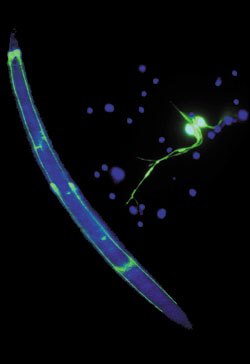
A primary cell culture, right, containing GFP-labeled "touch" neurons, which allow nematodes to sense gentle body touch. Cell nuclei in the cultures are stained with DAPI (blue). A C. elegans L1 larva, left, expressing a GFP-labeled protein in four "touch" neurons.
Caenorhabditis elegans – the “elegant worm”
What makes C. elegans a valuable model for scientific research? The worm is about as simple as an organism can be and still share a great number of biological similarities with human beings.
• The worm reproduces sexually, using sperm and eggs, and time from conception to adulthood is short—less than four days.
• The worm is made up of less than 1,000 cells, yet it has a fully formed nervous system, digestive tract, musculature, and reproductive system.
• The destination of each cell in development from zygote to adult is known, and a description of the complete anatomy of the adult worm has been documented at the level of electron microscope resolution.
• The transparent body allows for visualization of internal structures. The use of cell-specific fluorescent reporter genes makes the effects of genetic mutations on these structures easy to discern.
• The genome of the worm has been fully sequenced and is available on the World Wide Web.
• It’s really small, only 1 mm long, so a researcher can grow a lot of worms in a limited amount of space. This attribute is particularly important for genetic studies that require a large number of animals.
For more information on C. elegans and related research at Vanderbilt, visit http://www.vanderbilt.edu/exploration_dev/news/news_worm.htm.













